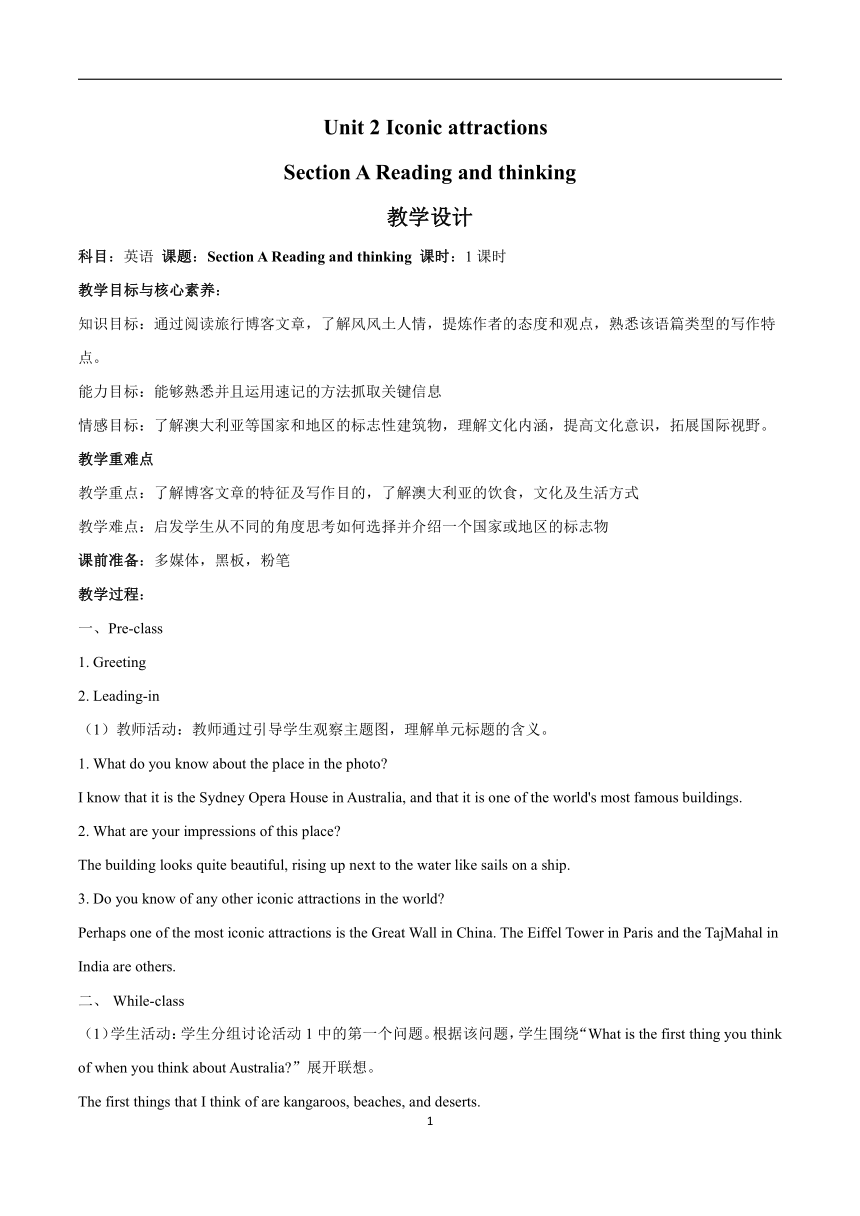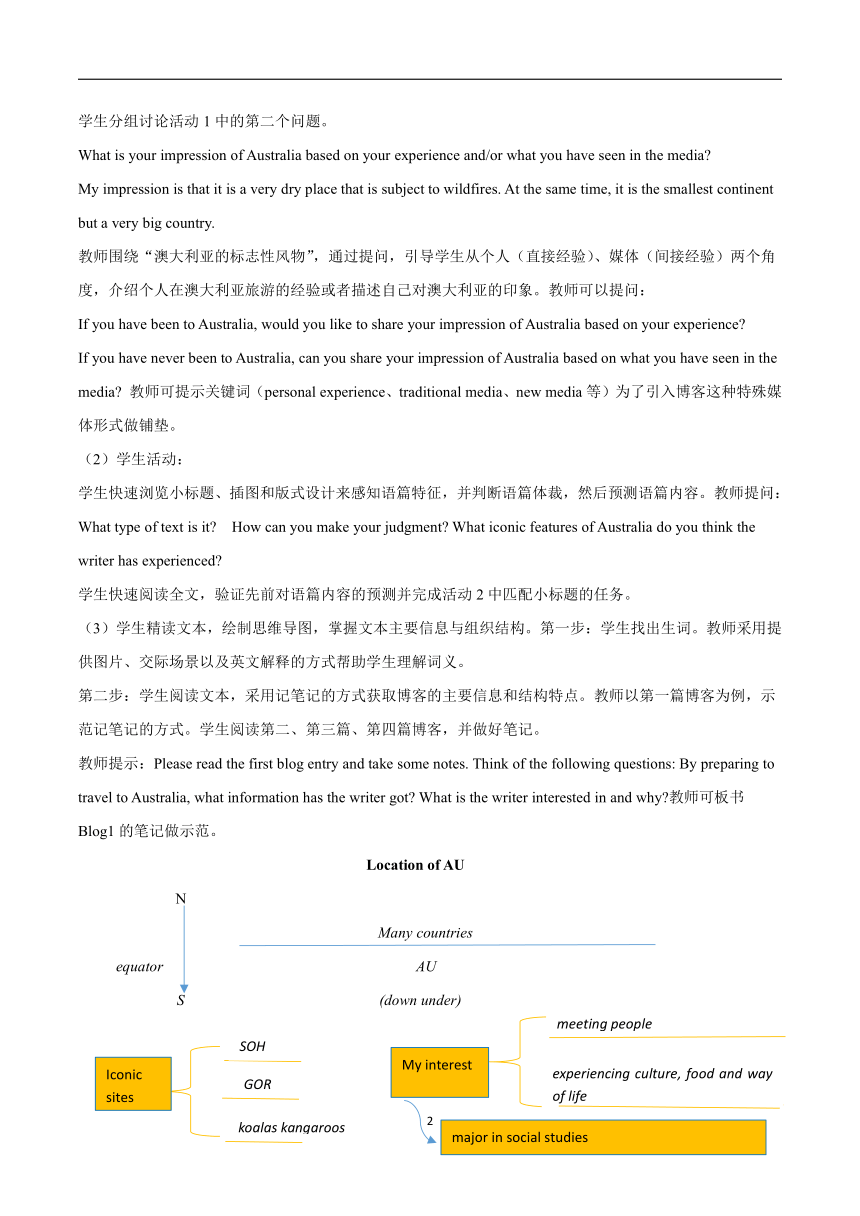人教版(2019)选择性必修第四册Unit 2 Iconic attractions Section A Reading and Thinking教案
文档属性
| 名称 | 人教版(2019)选择性必修第四册Unit 2 Iconic attractions Section A Reading and Thinking教案 |  | |
| 格式 | docx | ||
| 文件大小 | 57.9KB | ||
| 资源类型 | 教案 | ||
| 版本资源 | 人教版(2019) | ||
| 科目 | 英语 | ||
| 更新时间 | 2022-10-18 20:49:38 | ||
图片预览


文档简介
Unit 2 Iconic attractions
Section A Reading and thinking
教学设计
科目:英语 课题:Section A Reading and thinking 课时:1课时
教学目标与核心素养:
知识目标:通过阅读旅行博客文章,了解风风土人情,提炼作者的态度和观点,熟悉该语篇类型的写作特点。
能力目标:能够熟悉并且运用速记的方法抓取关键信息
情感目标:了解澳大利亚等国家和地区的标志性建筑物,理解文化内涵,提高文化意识,拓展国际视野。
教学重难点
教学重点:了解博客文章的特征及写作目的,了解澳大利亚的饮食,文化及生活方式
教学难点:启发学生从不同的角度思考如何选择并介绍一个国家或地区的标志物
课前准备:多媒体,黑板,粉笔
教学过程:
一、Pre-class
1. Greeting
2. Leading-in
(1)教师活动:教师通过引导学生观察主题图,理解单元标题的含义。
1. What do you know about the place in the photo
I know that it is the Sydney Opera House in Australia, and that it is one of the world's most famous buildings.
2. What are your impressions of this place
The building looks quite beautiful, rising up next to the water like sails on a ship.
3. Do you know of any other iconic attractions in the world
Perhaps one of the most iconic attractions is the Great Wall in China. The Eiffel Tower in Paris and the TajMahal in India are others.
While-class
(1)学生活动:学生分组讨论活动1中的第一个问题。根据该问题,学生围绕“What is the first thing you think of when you think about Australia ”展开联想。
The first things that I think of are kangaroos, beaches, and deserts.
学生分组讨论活动1中的第二个问题。
What is your impression of Australia based on your experience and/or what you have seen in the media
My impression is that it is a very dry place that is subject to wildfires. At the same time, it is the smallest continent but a very big country.
教师围绕“澳大利亚的标志性风物”,通过提问,引导学生从个人(直接经验)、媒体(间接经验)两个角度,介绍个人在澳大利亚旅游的经验或者描述自己对澳大利亚的印象。教师可以提问:
If you have been to Australia, would you like to share your impression of Australia based on your experience
If you have never been to Australia, can you share your impression of Australia based on what you have seen in the media 教师可提示关键词(personal experience、traditional media、new media等)为了引入博客这种特殊媒体形式做铺垫。
(2)学生活动:
学生快速浏览小标题、插图和版式设计来感知语篇特征,并判断语篇体裁,然后预测语篇内容。教师提问:What type of text is it How can you make your judgment What iconic features of Australia do you think the writer has experienced
学生快速阅读全文,验证先前对语篇内容的预测并完成活动2中匹配小标题的任务。
(3)学生精读文本,绘制思维导图,掌握文本主要信息与组织结构。第一步:学生找出生词。教师采用提供图片、交际场景以及英文解释的方式帮助学生理解词义。
第二步:学生阅读文本,采用记笔记的方式获取博客的主要信息和结构特点。教师以第一篇博客为例,示范记笔记的方式。学生阅读第二、第三篇、第四篇博客,并做好笔记。
教师提示:Please read the first blog entry and take some notes. Think of the following questions: By preparing to travel to Australia, what information has the writer got What is the writer interested in and why 教师可板书Blog1的笔记做示范。
Location of AU
N
Many countries
equator AU
S (down under)
(4)教师引导学生阅读教材第15页的阅读策略提示,明确两种记笔记的方法:使用关键词记录信息;使用缩写和速记符号。
Abbreviation Symbol
pare ∴ therefore
c. about/approximately ∵ because
imp. important/importance ≠ differs from, is the opposite of
tho. though = is/are/have/has/equals
(5)学生完成活动3。
1. What does“down under”mean
2. How has Australian cuisine been influenced by different cultures Give two examples.
3. What is the main theme reflected in Aboriginal music and why
4. What are the writer's first and biggest impressions of Australia Why
Suggested Answers
1. Australia.
2. A lot of typical Australian food, such as the Sunday roast, is originally British. The influence of Asian cultures, on the other hand, led to the introduction of bean curd and Asian herbs, along with Australian versions of foods like the Chinese-inspired dim sim.
3. It celebrates the natural world and the spiritual world around them, because to survive in the vast land, the Aborigines had to be in close contact with nature.
4. Her first impressions of Australia have been all about food, because her friend shared many different but yummy meals with her. Her biggest impression is the complicated mix of peoples and cultures that make up the nation. She feels this perhaps because of the many different kinds of people she met.
三、After-class
学生活动:学生分小组完成活动5。
Suggested Answers
Tourist sites: The Temple of Heaven and the Forbidden City, because these are iconic places that tell a lot about the Chinese culture.
Food and drinks: Jiaozi, because it is the most representative food for many Chinese people, especially in the north. Tea, as an old Chinese saying goes, "Firewood, rice, cooking oil, salt, sauce, vinegar, and tea are the seven necessities to begin a day."
Ethnic minority groups: The Miao people love singing their life aloud; the Dong people live with their traditional wind and rain bridges that give people shelter when it rains. I really enjoyed staying among them and learning about their culture.
Musical instruments: The pipa is one of the most popular Chinese instruments with over two thousand years of history. It can make very beautiful music and it has enlightenment on similar instruments in Japan and Korea. Clothes: The qipao, because it is such a beautiful dress, and so representative of the Chinese culture as a whole.
四、Summary
总结博客文本的特征和记笔记的方法。
2
Section A Reading and thinking
教学设计
科目:英语 课题:Section A Reading and thinking 课时:1课时
教学目标与核心素养:
知识目标:通过阅读旅行博客文章,了解风风土人情,提炼作者的态度和观点,熟悉该语篇类型的写作特点。
能力目标:能够熟悉并且运用速记的方法抓取关键信息
情感目标:了解澳大利亚等国家和地区的标志性建筑物,理解文化内涵,提高文化意识,拓展国际视野。
教学重难点
教学重点:了解博客文章的特征及写作目的,了解澳大利亚的饮食,文化及生活方式
教学难点:启发学生从不同的角度思考如何选择并介绍一个国家或地区的标志物
课前准备:多媒体,黑板,粉笔
教学过程:
一、Pre-class
1. Greeting
2. Leading-in
(1)教师活动:教师通过引导学生观察主题图,理解单元标题的含义。
1. What do you know about the place in the photo
I know that it is the Sydney Opera House in Australia, and that it is one of the world's most famous buildings.
2. What are your impressions of this place
The building looks quite beautiful, rising up next to the water like sails on a ship.
3. Do you know of any other iconic attractions in the world
Perhaps one of the most iconic attractions is the Great Wall in China. The Eiffel Tower in Paris and the TajMahal in India are others.
While-class
(1)学生活动:学生分组讨论活动1中的第一个问题。根据该问题,学生围绕“What is the first thing you think of when you think about Australia ”展开联想。
The first things that I think of are kangaroos, beaches, and deserts.
学生分组讨论活动1中的第二个问题。
What is your impression of Australia based on your experience and/or what you have seen in the media
My impression is that it is a very dry place that is subject to wildfires. At the same time, it is the smallest continent but a very big country.
教师围绕“澳大利亚的标志性风物”,通过提问,引导学生从个人(直接经验)、媒体(间接经验)两个角度,介绍个人在澳大利亚旅游的经验或者描述自己对澳大利亚的印象。教师可以提问:
If you have been to Australia, would you like to share your impression of Australia based on your experience
If you have never been to Australia, can you share your impression of Australia based on what you have seen in the media 教师可提示关键词(personal experience、traditional media、new media等)为了引入博客这种特殊媒体形式做铺垫。
(2)学生活动:
学生快速浏览小标题、插图和版式设计来感知语篇特征,并判断语篇体裁,然后预测语篇内容。教师提问:What type of text is it How can you make your judgment What iconic features of Australia do you think the writer has experienced
学生快速阅读全文,验证先前对语篇内容的预测并完成活动2中匹配小标题的任务。
(3)学生精读文本,绘制思维导图,掌握文本主要信息与组织结构。第一步:学生找出生词。教师采用提供图片、交际场景以及英文解释的方式帮助学生理解词义。
第二步:学生阅读文本,采用记笔记的方式获取博客的主要信息和结构特点。教师以第一篇博客为例,示范记笔记的方式。学生阅读第二、第三篇、第四篇博客,并做好笔记。
教师提示:Please read the first blog entry and take some notes. Think of the following questions: By preparing to travel to Australia, what information has the writer got What is the writer interested in and why 教师可板书Blog1的笔记做示范。
Location of AU
N
Many countries
equator AU
S (down under)
(4)教师引导学生阅读教材第15页的阅读策略提示,明确两种记笔记的方法:使用关键词记录信息;使用缩写和速记符号。
Abbreviation Symbol
pare ∴ therefore
c. about/approximately ∵ because
imp. important/importance ≠ differs from, is the opposite of
tho. though = is/are/have/has/equals
(5)学生完成活动3。
1. What does“down under”mean
2. How has Australian cuisine been influenced by different cultures Give two examples.
3. What is the main theme reflected in Aboriginal music and why
4. What are the writer's first and biggest impressions of Australia Why
Suggested Answers
1. Australia.
2. A lot of typical Australian food, such as the Sunday roast, is originally British. The influence of Asian cultures, on the other hand, led to the introduction of bean curd and Asian herbs, along with Australian versions of foods like the Chinese-inspired dim sim.
3. It celebrates the natural world and the spiritual world around them, because to survive in the vast land, the Aborigines had to be in close contact with nature.
4. Her first impressions of Australia have been all about food, because her friend shared many different but yummy meals with her. Her biggest impression is the complicated mix of peoples and cultures that make up the nation. She feels this perhaps because of the many different kinds of people she met.
三、After-class
学生活动:学生分小组完成活动5。
Suggested Answers
Tourist sites: The Temple of Heaven and the Forbidden City, because these are iconic places that tell a lot about the Chinese culture.
Food and drinks: Jiaozi, because it is the most representative food for many Chinese people, especially in the north. Tea, as an old Chinese saying goes, "Firewood, rice, cooking oil, salt, sauce, vinegar, and tea are the seven necessities to begin a day."
Ethnic minority groups: The Miao people love singing their life aloud; the Dong people live with their traditional wind and rain bridges that give people shelter when it rains. I really enjoyed staying among them and learning about their culture.
Musical instruments: The pipa is one of the most popular Chinese instruments with over two thousand years of history. It can make very beautiful music and it has enlightenment on similar instruments in Japan and Korea. Clothes: The qipao, because it is such a beautiful dress, and so representative of the Chinese culture as a whole.
四、Summary
总结博客文本的特征和记笔记的方法。
2
